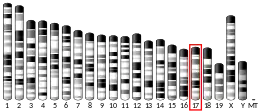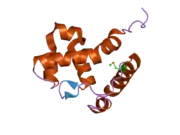ARID1B
AT-rich interactive domain-containing protein 1B is a protein that in humans is encoded by the ARID1B gene.[5] ARID1B is a component of the human SWI/SNF chromatin remodeling complex.
| ARID1B | |||||||||||||||||||||||||||||||||||||||||||||||||||
|---|---|---|---|---|---|---|---|---|---|---|---|---|---|---|---|---|---|---|---|---|---|---|---|---|---|---|---|---|---|---|---|---|---|---|---|---|---|---|---|---|---|---|---|---|---|---|---|---|---|---|---|
 | |||||||||||||||||||||||||||||||||||||||||||||||||||
| |||||||||||||||||||||||||||||||||||||||||||||||||||
| Identifiers | |||||||||||||||||||||||||||||||||||||||||||||||||||
| Aliases | ARID1B, 6A3-5, BAF250B, BRIGHT, DAN15, ELD/OSA1, MRD12, OSA2, P250R, CSS1, AT-rich interaction domain 1B, SMARCF2 | ||||||||||||||||||||||||||||||||||||||||||||||||||
| External IDs | OMIM: 614556 MGI: 1926129 HomoloGene: 32344 GeneCards: ARID1B | ||||||||||||||||||||||||||||||||||||||||||||||||||
| |||||||||||||||||||||||||||||||||||||||||||||||||||
| |||||||||||||||||||||||||||||||||||||||||||||||||||
| |||||||||||||||||||||||||||||||||||||||||||||||||||
| |||||||||||||||||||||||||||||||||||||||||||||||||||
| Wikidata | |||||||||||||||||||||||||||||||||||||||||||||||||||
| |||||||||||||||||||||||||||||||||||||||||||||||||||
Clinical significance
Germline mutations in ARID1B are associated with Coffin–Siris syndrome.[6][7] Somatic mutations in ARID1B are associated with several cancer subtypes, suggesting that it is a tumor suppressor gene.[8][9][10][11]
References
- GRCh38: Ensembl release 89: ENSG00000049618 - Ensembl, May 2017
- GRCm38: Ensembl release 89: ENSMUSG00000069729 - Ensembl, May 2017
- "Human PubMed Reference:". National Center for Biotechnology Information, U.S. National Library of Medicine.
- "Mouse PubMed Reference:". National Center for Biotechnology Information, U.S. National Library of Medicine.
- "Entrez Gene: ARID1B AT rich interactive domain 1B (SWI1-like)".
- Tsurusaki Y, Okamoto N, Ohashi H, Kosho T, Imai Y, Hibi-Ko Y, Kaname T, Naritomi K, Kawame H, Wakui K, Fukushima Y, Homma T, Kato M, Hiraki Y, Yamagata T, Yano S, Mizuno S, Sakazume S, Ishii T, Nagai T, Shiina M, Ogata K, Ohta T, Niikawa N, Miyatake S, Okada I, Mizuguchi T, Doi H, Saitsu H, Miyake N, Matsumoto N (April 2012). "Mutations affecting components of the SWI/SNF complex cause Coffin-Siris syndrome". Nat. Genet. 44 (4): 376–8. doi:10.1038/ng.2219. PMID 22426308. S2CID 205345340.
- Santen GW, Aten E, Sun Y, Almomani R, Gilissen C, Nielsen M, Kant SG, Snoeck IN, Peeters EA, Hilhorst-Hofstee Y, Wessels MW, den Hollander NS, Ruivenkamp CA, van Ommen GJ, Breuning MH, den Dunnen JT, van Haeringen A, Kriek M (April 2012). "Mutations in SWI/SNF chromatin remodeling complex gene ARID1B cause Coffin-Siris syndrome". Nat. Genet. 44 (4): 379–80. doi:10.1038/ng.2217. PMID 22426309. S2CID 205345323.
- Shain AH, Pollack JR (2013). "The spectrum of SWI/SNF mutations, ubiquitous in human cancers". PLOS ONE. 8 (1): e55119. Bibcode:2013PLoSO...855119S. doi:10.1371/journal.pone.0055119. PMC 3552954. PMID 23355908.
- Sausen M, Leary RJ, Jones S, Wu J, Reynolds CP, Liu X, Blackford A, Parmigiani G, Diaz LA, Papadopoulos N, Vogelstein B, Kinzler KW, Velculescu VE, Hogarty MD (January 2013). "Integrated genomic analyses identify ARID1A and ARID1B alterations in the childhood cancer neuroblastoma". Nat. Genet. 45 (1): 12–7. doi:10.1038/ng.2493. PMC 3557959. PMID 23202128.
- Shain AH, Giacomini CP, Matsukuma K, Karikari CA, Bashyam MD, Hidalgo M, Maitra A, Pollack JR (January 2012). "Convergent structural alterations define SWItch/Sucrose NonFermentable (SWI/SNF) chromatin remodeler as a central tumor suppressive complex in pancreatic cancer". Proc. Natl. Acad. Sci. U.S.A. 109 (5): E252–9. doi:10.1073/pnas.1114817109. PMC 3277150. PMID 22233809.
- Fujimoto A, Totoki Y, Abe T, Boroevich KA, Hosoda F, Nguyen HH, Aoki M, Hosono N, Kubo M, Miya F, Arai Y, Takahashi H, Shirakihara T, Nagasaki M, Shibuya T, Nakano K, Watanabe-Makino K, Tanaka H, Nakamura H, Kusuda J, Ojima H, Shimada K, Okusaka T, Ueno M, Shigekawa Y, Kawakami Y, Arihiro K, Ohdan H, Gotoh K, Ishikawa O, Ariizumi S, Yamamoto M, Yamada T, Chayama K, Kosuge T, Yamaue H, Kamatani N, Miyano S, Nakagama H, Nakamura Y, Tsunoda T, Shibata T, Nakagawa H (July 2012). "Whole-genome sequencing of liver cancers identifies etiological influences on mutation patterns and recurrent mutations in chromatin regulators". Nat. Genet. 44 (7): 760–4. doi:10.1038/ng.2291. PMID 22634756. S2CID 54585617.
- Hurlstone AF, Olave IA, Barker N, van Noort M, Clevers H (May 2002). "Cloning and characterization of hELD/OSA1, a novel BRG1 interacting protein". Biochem. J. 364 (Pt 1): 255–64. doi:10.1042/bj3640255. PMC 1222568. PMID 11988099.
- Inoue H, Furukawa T, Giannakopoulos S, Zhou S, King DS, Tanese N (November 2002). "Largest subunits of the human SWI/SNF chromatin-remodeling complex promote transcriptional activation by steroid hormone receptors". J. Biol. Chem. 277 (44): 41674–85. doi:10.1074/jbc.M205961200. PMID 12200431.
Further reading
- Martens JA, Winston F (2003). "Recent advances in understanding chromatin remodeling by Swi/Snf complexes". Curr. Opin. Genet. Dev. 13 (2): 136–42. doi:10.1016/S0959-437X(03)00022-4. PMID 12672490.
- Bonaldo MF, Lennon G, Soares MB (1997). "Normalization and subtraction: two approaches to facilitate gene discovery". Genome Res. 6 (9): 791–806. doi:10.1101/gr.6.9.791. PMID 8889548.
- Imbert G, Saudou F, Yvert G, et al. (1996). "Cloning of the gene for spinocerebellar ataxia 2 reveals a locus with high sensitivity to expanded CAG/glutamine repeats". Nat. Genet. 14 (3): 285–91. doi:10.1038/ng1196-285. PMID 8896557. S2CID 9304975.
- Mangel L, Ternes T, Schmitz B, Doerfler W (1998). "New 5'-(CGG)n-3' repeats in the human genome". J. Biol. Chem. 273 (46): 30466–71. doi:10.1074/jbc.273.46.30466. PMID 9804814.
- Phelan ML, Sif S, Narlikar GJ, Kingston RE (1999). "Reconstitution of a core chromatin remodeling complex from SWI/SNF subunits". Mol. Cell. 3 (2): 247–53. doi:10.1016/S1097-2765(00)80315-9. PMID 10078207.
- Nagase T, Ishikawa K, Kikuno R, et al. (2000). "Prediction of the coding sequences of unidentified human genes. XV. The complete sequences of 100 new cDNA clones from brain which code for large proteins in vitro". DNA Res. 6 (5): 337–45. doi:10.1093/dnares/6.5.337. PMID 10574462.
- Xue Y, Canman JC, Lee CS, et al. (2001). "The human SWI/SNF-B chromatin-remodeling complex is related to yeast Rsc and localizes at kinetochores of mitotic chromosomes". Proc. Natl. Acad. Sci. U.S.A. 97 (24): 13015–20. doi:10.1073/pnas.240208597. PMC 27170. PMID 11078522.
- Kato H, Tjernberg A, Zhang W, et al. (2002). "SYT associates with human SNF/SWI complexes and the C-terminal region of its fusion partner SSX1 targets histones". J. Biol. Chem. 277 (7): 5498–505. doi:10.1074/jbc.M108702200. PMID 11734557.
- Hurlstone AF, Olave IA, Barker N, et al. (2002). "Cloning and characterization of hELD/OSA1, a novel BRG1 interacting protein". Biochem. J. 364 (Pt 1): 255–64. doi:10.1042/bj3640255. PMC 1222568. PMID 11988099.
- Inoue H, Furukawa T, Giannakopoulos S, et al. (2003). "Largest subunits of the human SWI/SNF chromatin-remodeling complex promote transcriptional activation by steroid hormone receptors". J. Biol. Chem. 277 (44): 41674–85. doi:10.1074/jbc.M205961200. PMID 12200431.
- Strausberg RL, Feingold EA, Grouse LH, et al. (2003). "Generation and initial analysis of more than 15,000 full-length human and mouse cDNA sequences". Proc. Natl. Acad. Sci. U.S.A. 99 (26): 16899–903. Bibcode:2002PNAS...9916899M. doi:10.1073/pnas.242603899. PMC 139241. PMID 12477932.
- Nie Z, Yan Z, Chen EH, et al. (2003). "Novel SWI/SNF Chromatin-Remodeling Complexes Contain a Mixed-Lineage Leukemia Chromosomal Translocation Partner". Mol. Cell. Biol. 23 (8): 2942–52. doi:10.1128/MCB.23.8.2942-2952.2003. PMC 152562. PMID 12665591.
- Mungall AJ, Palmer SA, Sims SK, et al. (2003). "The DNA sequence and analysis of human chromosome 6". Nature. 425 (6960): 805–11. Bibcode:2003Natur.425..805M. doi:10.1038/nature02055. PMID 14574404.
- Garin G, Badid C, McGregor B, et al. (2004). "Ischemia Induces Early Expression of a New Transcription Factor (6A3-5) in Kidney Vascular Smooth Muscle Cells : Studies in Rat and Human Renal Pathology". Am. J. Pathol. 163 (6): 2485–94. doi:10.1016/S0002-9440(10)63603-6. PMC 1892391. PMID 14633620.
- Ota T, Suzuki Y, Nishikawa T, et al. (2004). "Complete sequencing and characterization of 21,243 full-length human cDNAs". Nat. Genet. 36 (1): 40–5. doi:10.1038/ng1285. PMID 14702039.
- Bouwmeester T, Bauch A, Ruffner H, et al. (2004). "A physical and functional map of the human TNF-alpha/NF-kappa B signal transduction pathway". Nat. Cell Biol. 6 (2): 97–105. doi:10.1038/ncb1086. PMID 14743216. S2CID 11683986.
- Wilsker D, Patsialou A, Zumbrun SD, et al. (2004). "The DNA-binding properties of the ARID-containing subunits of yeast and mammalian SWI/SNF complexes". Nucleic Acids Res. 32 (4): 1345–53. doi:10.1093/nar/gkh277. PMC 390273. PMID 14982958.
- Wang X, Nagl NG, Wilsker D, et al. (2005). "Two related ARID family proteins are alternative subunits of human SWI/SNF complexes". Biochem. J. 383 (Pt 2): 319–25. doi:10.1042/BJ20040524. PMC 1134073. PMID 15170388.
- Colland F, Jacq X, Trouplin V, et al. (2004). "Functional Proteomics Mapping of a Human Signaling Pathway". Genome Res. 14 (7): 1324–32. doi:10.1101/gr.2334104. PMC 442148. PMID 15231748.
External links
- ARID1B+protein,+human at the U.S. National Library of Medicine Medical Subject Headings (MeSH)
- Human ARID1B genome location and ARID1B gene details page in the UCSC Genome Browser.
This article incorporates text from the United States National Library of Medicine, which is in the public domain.
This article is issued from Wikipedia. The text is licensed under Creative Commons - Attribution - Sharealike. Additional terms may apply for the media files.




